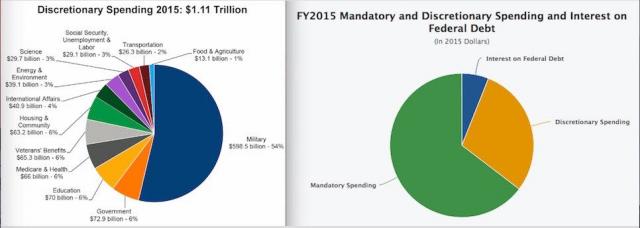

| Online: | |
| Visits: | |
| Stories: |

| Story Views | |
| Now: | |
| Last Hour: | |
| Last 24 Hours: | |
| Total: | |
Depending on What Denominator You Use, the US Spends Either 62% or 42% of the Federal Budget on the Military
Dave Lindorff
Economist Dean Baker, in an article published at NationofChange, complains that the New York Times never explains the federal budget in a way that Americans can comprehend, because it publishes big numbers, like the billions of dollars spent on welfare or on foreign aid, but never notes that neither of those “big” numbers amounts to even 1% of the federal budget. His critique is correct as far as it goes, but like all too many liberal analysts, Baker studiously fails to note a few really BIG numbers in the budget that also don't get mentioned by the Times and the rest of the corporate media, either as a number or as a percentage.
This is a big failing of the liberal left: not calling out the Hannibal's war elephant in the room.
Military spending, even when it does get reported, is often only referred to in terms of the increase being proposed, without the total ever being provided. It is reported (in the Times!) wrong in so many ways. For example, while the actual budget outlay is sometimes mentioned, the amount of the interest on the debt that is for prior military spending that was financed through borrowing is not included. Nor is the spending on veterans' health care, which is surely part of military spending. Nor is the share of the Energy Dept. budget that is for nuclear weapons included. According to the National Priorities Project, the 2015 budget for the military was $598 billion, which represented 54% of all federal discretionary spending. That number didn't include $65 billion in veterans spending and $26 billion for nuclear weapons, bringing the total to about $690 billion, or 63% of all discretionary spending. 2015 total discretionary spending was $1.1 trillion, including nuke spending and veterans spending, spending on the military represented 63% of the total.
 (National Priorities Project chart)
(National Priorities Project chart)
A news collective, founded as a blog in 2004, covering war, politics, environment, economy, culture and all the madness
Source: http://thiscantbehappening.net/node/3504




The product of the means = the product of the extremes. Percentage always has a denominator of 100. It follow that 62 percent is 62/100. So to find the correct percentage you have (military spending/ Gross income = X/100). I recommend however that the interest owed should be taken into account. That would come off of gross income.